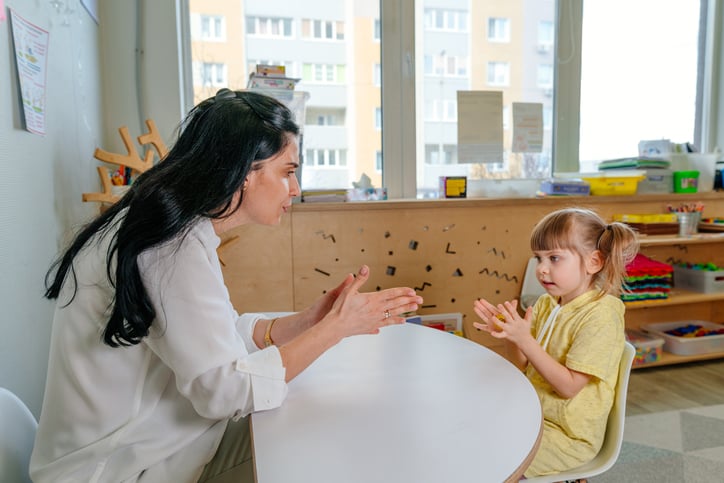What Are the Three Levels of Autism?
We often hear people reference "high-functioning autism" and "low-functioning autism." But in fact, those who work with children with autism tend not to rely on labels such as "high functioning" and "low functioning." While it is recognized that autism occurs on a spectrum and affects each individual differently, it can also be useful to categorize autism into 3 levels. The DSM-5 categorizes autism using three levels to cover the areas of repetitive behaviors and social communication.1 Each of the three levels (i.e., Level 1, 2, and 3) are delineated based on a person’s current level of functioning–and need for support–in the areas of social cognition, communication, and behavior.
Each level describes, identifies, and predicts the intensity of support necessary for assisting individuals on the autism spectrum according to their specific strengths, weaknesses, and long-term goals for personal success. Based on information obtained during professional assessments, treatment plans can be effectively tailored, targeted, and implemented to support the unique and various needs of each learner.
Level 1: Requiring Support
The first level–requiring support–indicates the need for some specialized services and is, generally, considered the least severe level. Individuals on the autism spectrum who fall into this category may benefit from building Theory of Mind (ToM) skills, such as understanding the thoughts, feelings, emotions, and perspectives of others–while also improving social-emotional regulation, executive functioning, cognitive flexibility, communication, and coping skills in the interim.2
Those with Level 1 autism may struggle with some (or a combination) of the following:
 Rigid patterns of behavior
Rigid patterns of behavior- Fixed (or highly specialized) interests and passions
- Limited eye contact and difficulty initiating and maintaining conversations with others
- A reduced ability to cope with changes in schedule or routine 3
- Challenges with executive functioning (EF) skills, including planning, organizing, and time management
Although neurodiverse individuals may struggle with social, communication, and behavioral differences when compared to their typically developing peers, it is important to keep in mind that progress can be made as strategies and interventions are adapted, established, and developed to suit the needs of each person with autism.
Several specific strategies for supporting those who fall into the Level 1 category include:
- Implementing a daily schedule that allows for some changes in routine to occur periodically
- Working with educators to develop an effective Individualized Education Plan (IEP) for the learner
- Creating coping and stress management techniques that can be used at the moment when plans change, when there is a miscommunication, or when the individual becomes noticeably frustrated
- Developing Theory of Mind (ToM) skills to improve perspective-taking, cognitive flexibility, and emotional regulation abilities
With a strategic team approach, the challenges presented by those with Level 1 autism can be supported and overcome as the learner develops new approaches for improving self-management, perspective-taking, executive functioning, and personal daily living skills.
Level 2: Requiring Substantial Support
Individuals falling into Level 2 require more support than those in Level 1 and may struggle to communicate clearly with others, have difficulty engaging appropriately in social situations, may misinterpret body language, and might only discuss a limited number of topics during conversation.1 Daily functioning can be markedly reduced, and individuals may display poor social awareness–as well as a lack of daily living skills, such as bathing regularly, maintaining proper nutrition, and getting adequate sleep. Support in each of these areas is vital, and those with autism often benefit from receiving an individualized approach that is tailored specifically to their unique needs both in the short term and long term.
 Although learners with Level 2 autism might only communicate in short or fragmented sentences, establishing an effective form of functional communication is key to success. One’s personal needs must be adequately and consistently met before other goals can be prioritized, and–because challenging behaviors can stem from a lack of reliable communication–finding an appropriate form of communication (i.e., one that is functional across various contexts and settings) is necessary and essential.
Although learners with Level 2 autism might only communicate in short or fragmented sentences, establishing an effective form of functional communication is key to success. One’s personal needs must be adequately and consistently met before other goals can be prioritized, and–because challenging behaviors can stem from a lack of reliable communication–finding an appropriate form of communication (i.e., one that is functional across various contexts and settings) is necessary and essential.
Forms of functional communication can include:
- Sign language or hand gestures4
- Picture exchange communication systems (PECS) with picture symbols
- Use of short words or phrases
- Voice output communication aids (VOCAs)
The unique strengths and weaknesses of each individual on the spectrum should always be taken into account as an effective form of communication is considered, established, and implemented with the learner.
Level 3: Requiring Very Substantial Support
Level 3 describes individuals who require a significant amount of support and might display highly restricted and/or repetitive behaviors, a marked difficulty with changes in routine, extreme inflexibility, or other skill deficits contributing to notable challenges in functioning across all contexts.5 Because these areas are likely to significantly impact activities of daily living and interfere greatly with independence skills, specialized support is always required.
Individuals classified as having Level 3 autism often exhibit “severe deficits in verbal and nonverbal social communication skills [causing] impairments in functioning, very limited initiation of social interactions, and minimal response to social overtures from others.”5 A combination of these factors can result in social isolation if not adequately and sufficiently addressed in a timely manner. It is important to note that learners at this level may not speak verbally or may attempt to communicate using unintelligible words, phrases, or sounds. Social interactions of any kind are often awkward, strained, draining, and avoided–and individuals typically lack the skills necessary to initiate and maintain social engagements with others.6
The following can be helpful when supporting an individual with Level 3 autism:
- Creating sensory-informed interventions based on the unique needs of the learner (e.g., those on the spectrum can be over-sensitive or under-sensitive to sensory stimuli, and support strategies should be tailored accordingly.)7
- Developing plans with a functional form of communication for the learner–such as sign language, hand gestures, use of short words or phrases, picture exchange communication systems (PECS), or voice output communication aids (VOCAs)
- Establishing set daily routines and visual schedules with picture symbols that the individual understands the meaning of
- Using peer mentors as role models for positive behaviors that are being targeted (e.g., sitting quietly at one’s desk during class time, walking slowly in school hallways, adjusting the loudness of one’s voice when visiting the library, or waiting patiently to board the school bus at the end of the day)
- Encouraging a calm, positive, engaging, and supportive learning environment across all social settings–including at home, at school, in the grocery store, at the park, and during extracurricular activities
Although those with Level 3 autism may require additional assistance from others throughout their lives, progress can still be achieved in social, academic, and employment settings when adequate support is implemented regularly and consistently.
Summary
There are three levels of autism according to the DSM-5, and–because autism affects each person differently–not everyone on the spectrum presents with the same traits, characteristics, or struggles.
The first level of autism is, generally, considered the least severe, and individuals meeting the criteria for this level may only need slight modifications for success in academic, employment, and social settings. Those who are classified as having Level 2 autism often benefit from more extensive support and might need more intensive services that focus on behavioral interventions and building functional communication skills. Finally, learners with Level 3 autism frequently require the most significant and involved level of support and receive more intensive and consistent services than those with Level 2 autism.
It is important to remember that, regardless of an individual’s level of autism, progress can still be attained as interventions are carefully tailored to meet the unique needs of each learner. There is always hope.
Please share your thoughts about the three levels of autism. Has it been helpful to you to use these categories to help support autistic children?
And...check out our handout on specific support strategies for the 3 levels of autism!
References
- https://www.medicalnewstoday.com/articles/325106#symptoms
- https://aspiroadventure.com/blog/defining-level-1-autism-distinguishing-why-different-levels-of-care-are-needed-for-different-traits/
- https://www.allkindsoftherapy.com/blog/defining-the-levels-of-autism-spectrum-asd-faqs?fbclid=IwAR0ircqkRBSV3KrW20QhelHNzkSMtVMefIwLdZxgELvTabMIEhJduvcYKc0
- http://asd.yourschools.ca/functional-communication/#:~:text=Functional%20communication%20is%20the%20means,sign%20language%20and%20assistive%20devices
- https://www.autismspeaks.org/autism-diagnosis-criteria-dsm-5
- https://www.verywellhealth.com/what-are-the-three-levels-of-autism-260233
- https://www.elemy.com/studio/autism-and-education/teaching-strategies/

Kenna McEvoy
Kenna has a background working with children on the autism spectrum and enjoys supporting, encouraging, and motivating others to reach their full potential. She holds a bachelor's degree with graduate-level coursework in applied behavior analysis and autism spectrum disorders. During her experience as a direct therapist for children on the autism spectrum, she developed a passion for advocating for the health and well-being of those she serves in the areas of behavior change, parenting, education, and medical/mental health.





